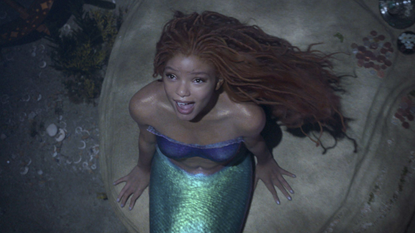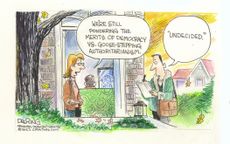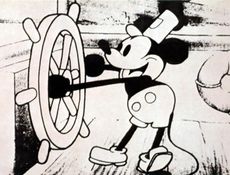The Little Mermaid: from terrifying tales to the 2023 blockbuster
Disney’s upcoming live-action version is one of many films inspired by Hans Christian Andersen’s ‘brutal’ story

The fairy-tale world’s little mermaid is making waves once again as Disney prepares to release a new live-action adaptation of the story.
Disney’s 1989 animated version “captivated audiences the world over”, scooped two Academy Awards and breathed “new life into the then-struggling film studio”, said HuffPost on the 30-year anniversary of the movie.
And protagonist Ariel will return to cinema screens this May, with Halle Bailey starring as the mermaid princess who longs to be a human.
Subscribe to The Week
Escape your echo chamber. Get the facts behind the news, plus analysis from multiple perspectives.

Sign up for The Week's Free Newsletters
From our morning news briefing to a weekly Good News Newsletter, get the best of The Week delivered directly to your inbox.
From our morning news briefing to a weekly Good News Newsletter, get the best of The Week delivered directly to your inbox.
But while Disney’s take on mermaids is “romantic and upbeat”, said Slash Film, traditional depictions are actually “terrifying”. The original Hans Christian Andersen 1837 fairy tale “has a brutal background that the Disney adaptation ignores”.
The Danish Mermaid
Andersen’s The Little Mermaid is so far from Disney’s version that “sometimes the source and the film serve as opposites”, said Collider. In his version, mermaids live for 300 years and then turn into sea foam, while human souls live on forever.
The mermaid wants an eternal soul to be with the prince she has rescued, but is warned by the sea witch that the cost of becoming human will be that “every step you take will feel as if you were treading upon knife blades” – and that she will die if the prince fails to fall in love with her.
When the prince does ultimately choose to marry another women, the mermaid can only save herself by “stabbing the prince through the heart and smearing his blood on her legs”, said Slash Film. But instead she opted to have her “tongue cut out” before dissolving into the waves.
This is “not the happily-ever-after romance Disney fans are familiar with, but a tale of torturous unrequited love” that the bisexual Andersen wrote when “a man he was infatuated with was getting married”, said Michelle Smith, a senior lecturer in literary studies at Australia’s Monash University, on The Conversation.
Other mermaids
The story has been adapted many times over the years, in print, audio, television and film. Mala Morska Vila, a 1976 Czech film version of Andersen’s story, is “a far cry from Disney’s 1989 version”, said Artpublika Magazine. Instead, the Czech adaption stays largely true to the Danish original.
A more recent remake, Agnieszka Smoczynska’s 2015 Polish film The Lure, was “a very different kind of fairy-fishtail”, said Variety. The musical horror follows two mermaid sisters who are also vampires and who cause “havoc” after venturing onto land and being hired as strippers.
The film was lauded at the Sundance festival, where it was awarded the jury prize for “unique vision and design”.
Disney’s mermaids
The 1989 cartoon adaptation “not only saved the company from almost certain death, but allowed Disney to become the international corporate juggernaut we know today”, said historian Michael Landis in Smithsonian Magazine. The movie, he argued, was “truly subversive cinema”, tackling drag, gay rights, body image issues and making “a courageous statement about identity in Reagan-era America”.
This Ariel was praised as a “modern new heroine”, said The Washington Post. She was described by critic Roger Ebert as a “fully realised female character who thinks and acts independently, even rebelliously”, in contrast to her princess predecessors.
Yet despite such praise, the upcoming live-action film is “anticipated to have significant differences” from “its animated counterpart”, said Screen Rant. Social values have shifted further in the past 30 years, and some of the old classic themes “would be considered problematic through a modern lens”.
Some of the changes have already triggered debate. The casting of a black actor as Ariel met with “deep outrage and indignation among fans” who argued that the increased diversity weakened “faithfulness to the original story”, said Vox’s culture reporter Aja Romano.
Challenging that criticism, Romano pointed out that Andersen’s tale was “originally a sublimated allegory for a closeted queer man, and its original setting was ‘far out in the ocean’”. So “seeking historical accuracy from this type of fairy tale seems like grasping at best”.

Continue reading for free
We hope you're enjoying The Week's refreshingly open-minded journalism.
Subscribed to The Week? Register your account with the same email as your subscription.
Sign up to our 10 Things You Need to Know Today newsletter
A free daily digest of the biggest news stories of the day - and the best features from our website
-
 Today's political cartoons - December 1, 2023
Today's political cartoons - December 1, 2023Cartoons Friday's cartoons - the undecided voter, Kissinger's last stand, and more
By The Week US Published
-
 Quiz of The Week: 25 - 1 December
Quiz of The Week: 25 - 1 DecemberPuzzles and Quizzes Have you been paying attention to The Week's news?
By Harriet Marsden, The Week UK Published
-
 Cop28: is the UK serious about tackling climate change?
Cop28: is the UK serious about tackling climate change?Today's Big Question The UK government has watered down a number of climate policies in recent months
By Sorcha Bradley, The Week UK Published
-
 TV to watch in December, from 'Percy Jackson and the Olympians' to 'What If...?'
TV to watch in December, from 'Percy Jackson and the Olympians' to 'What If...?'The Week Recommends Spend your December with Mr. D and Dr. Who
By Brendan Morrow, The Week US Published
-
 7 new children's movies to watch this holiday season
7 new children's movies to watch this holiday seasonFeature Entertain your kids — and yourself — with these family films coming through the end of 2023
By Brendan Morrow, The Week US Published
-
 Movies to watch in November, from 'The Marvels' to 'The Hunger Games: The Ballad of Songbirds & Snakes'
Movies to watch in November, from 'The Marvels' to 'The Hunger Games: The Ballad of Songbirds & Snakes'Feature From the big franchises to the critically-acclaimed Oscar hopefuls
By Brendan Morrow, The Week US Published
-
 TV to watch in October, from 'Loki' to 'The Fall of the House of Usher'
TV to watch in October, from 'Loki' to 'The Fall of the House of Usher'The Explainer Celebrate spooky season with some eerie streaming shows
By Brendan Morrow Published
-
 Why Disney World is so empty this summer
Why Disney World is so empty this summerThe Explainer The park recently saw its slowest July Fourth weekend in nearly a decade
By Justin Klawans Published
-
 Characters in the public domain, explained
Characters in the public domain, explainedSpeed Read Winnie the Pooh just starred in a slasher film. Is Mickey Mouse next?
By Theara Coleman Published
-
 Disney+ and Hulu to remove content in cost-cutting measure
Disney+ and Hulu to remove content in cost-cutting measureSpeed Read
By Brendan Morrow Published
-
 Hollywood writers go on strike for first time in 15 years
Hollywood writers go on strike for first time in 15 yearsSpeed Read Writers Guild of America warns that ‘survival of writing as a profession is at stake’
By Arion McNicoll Published










